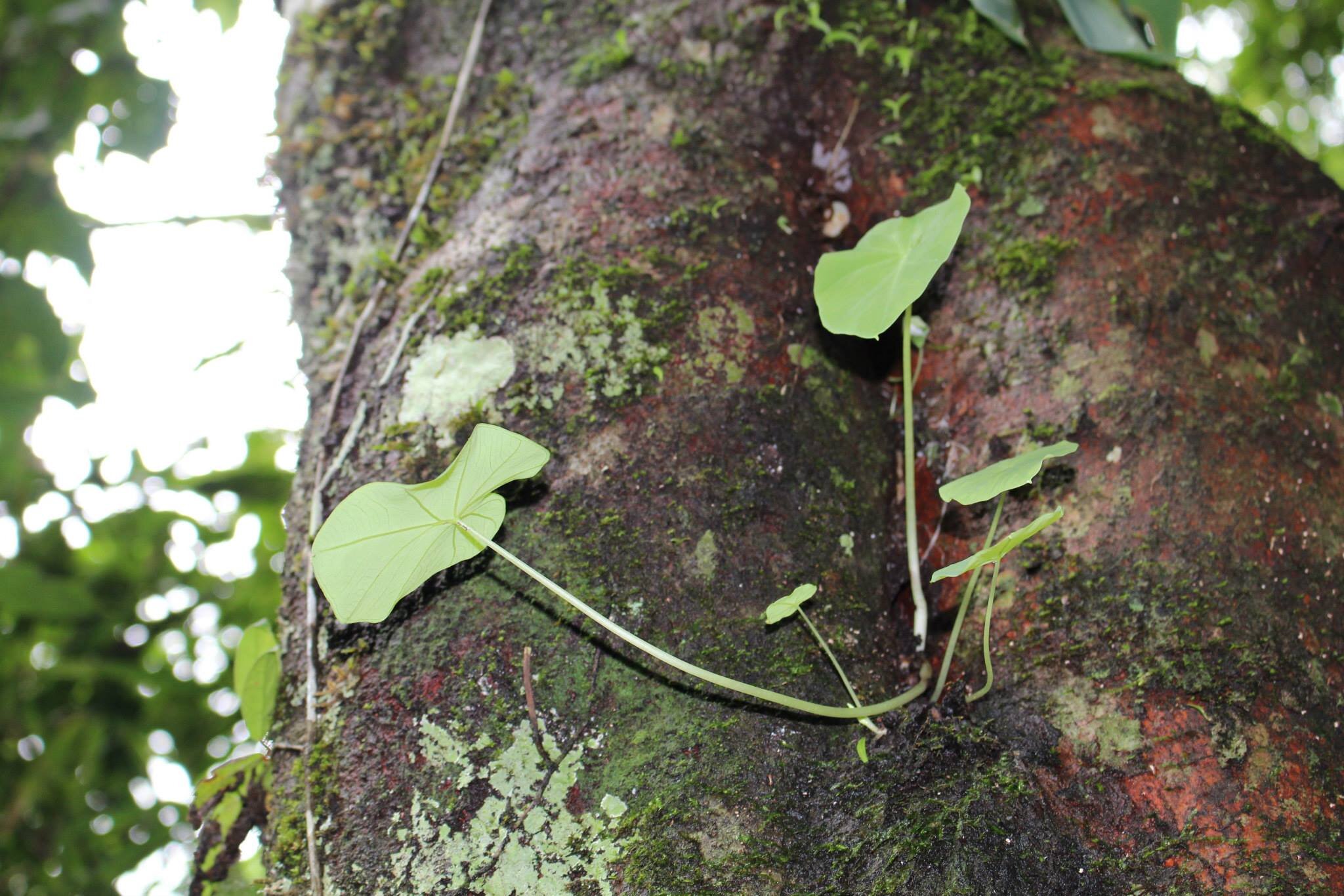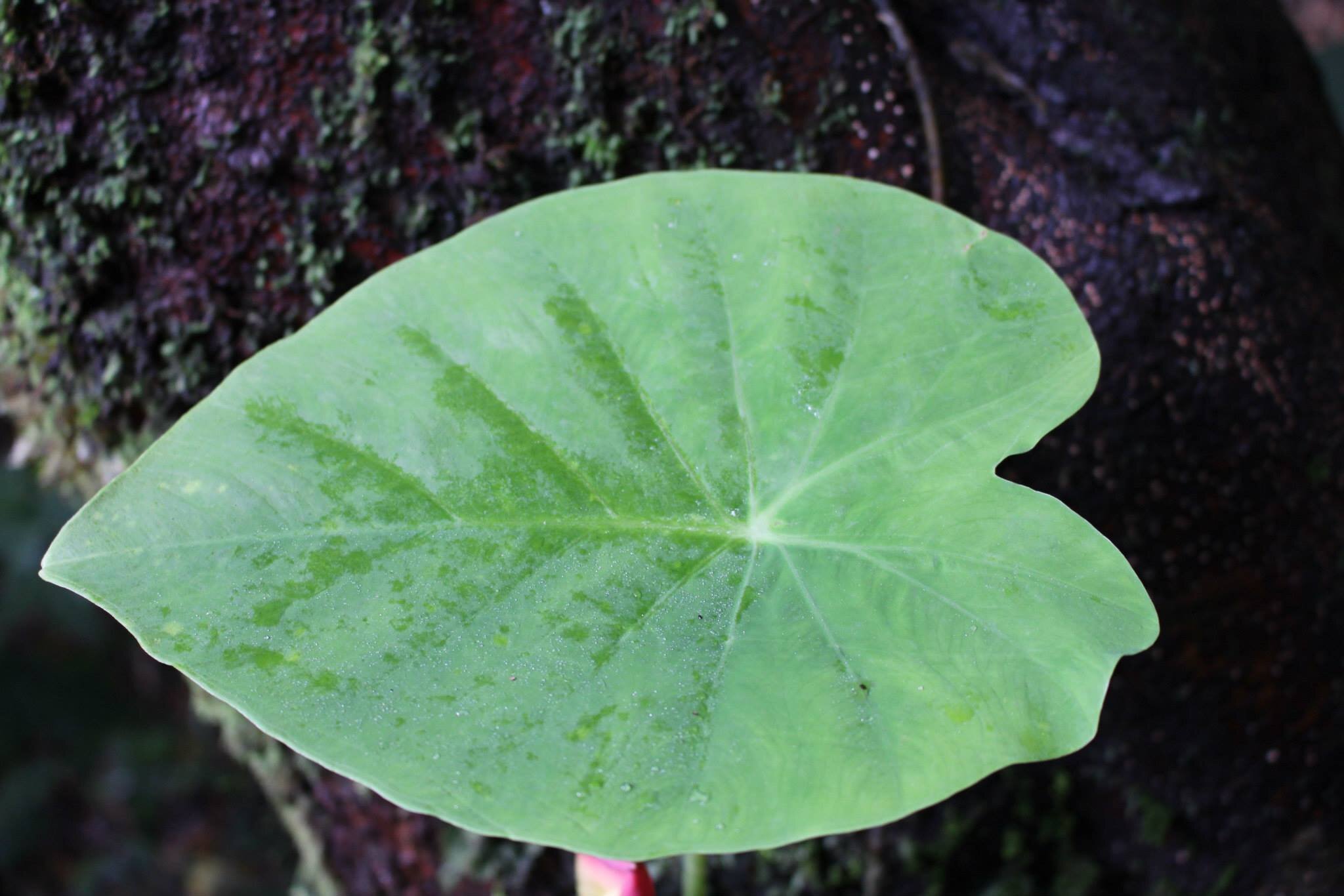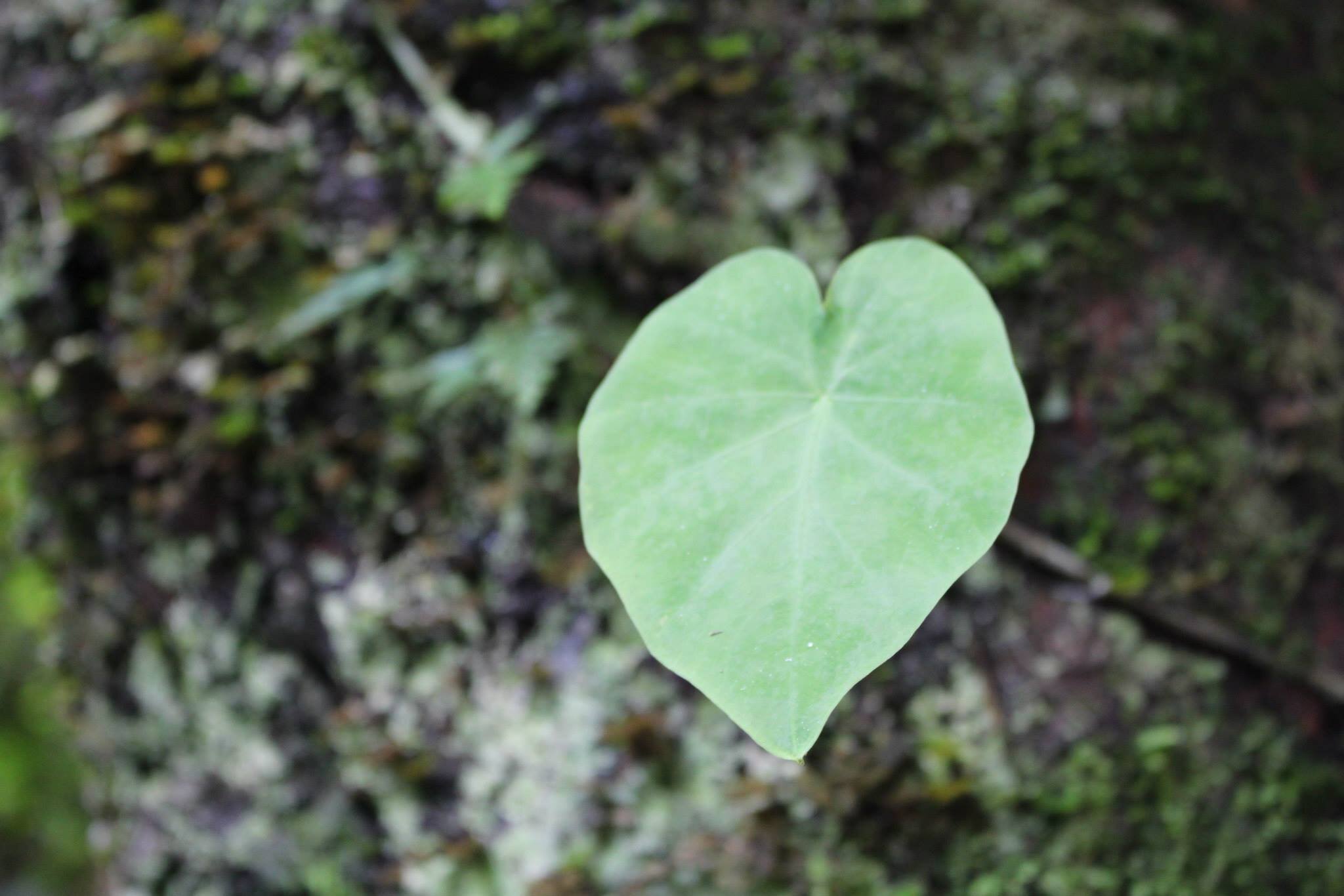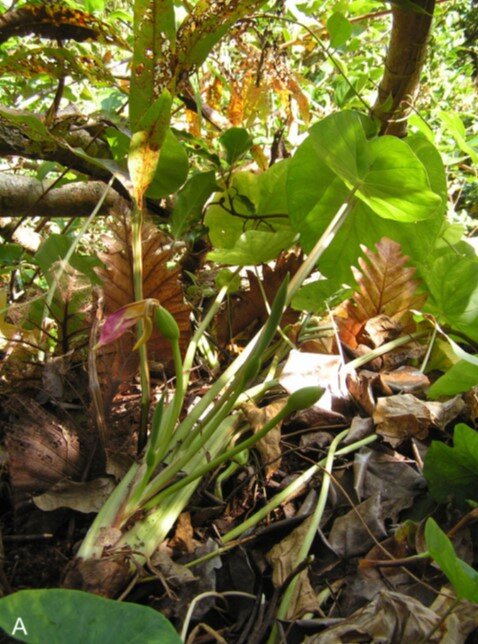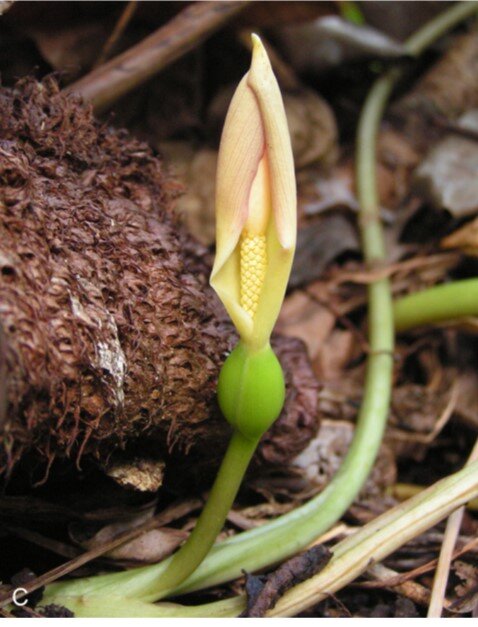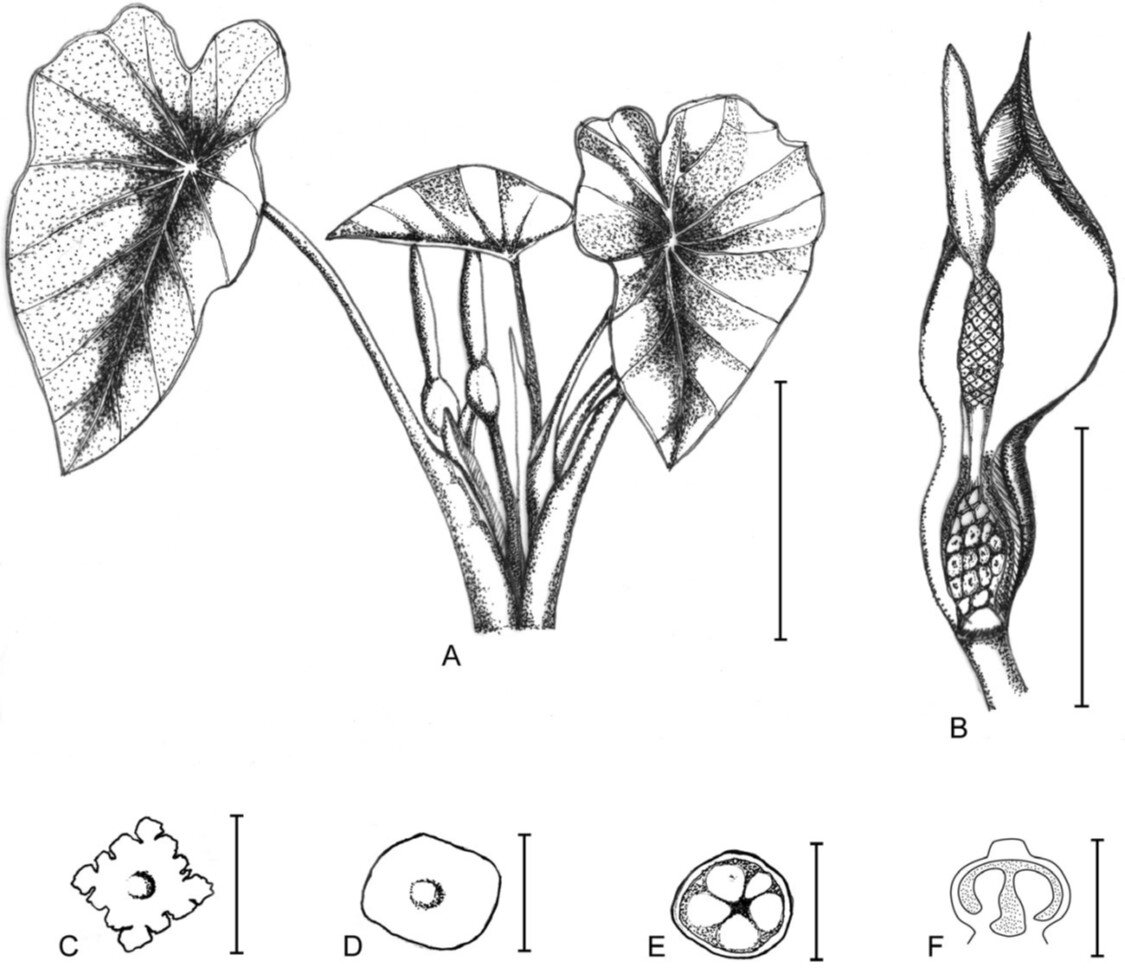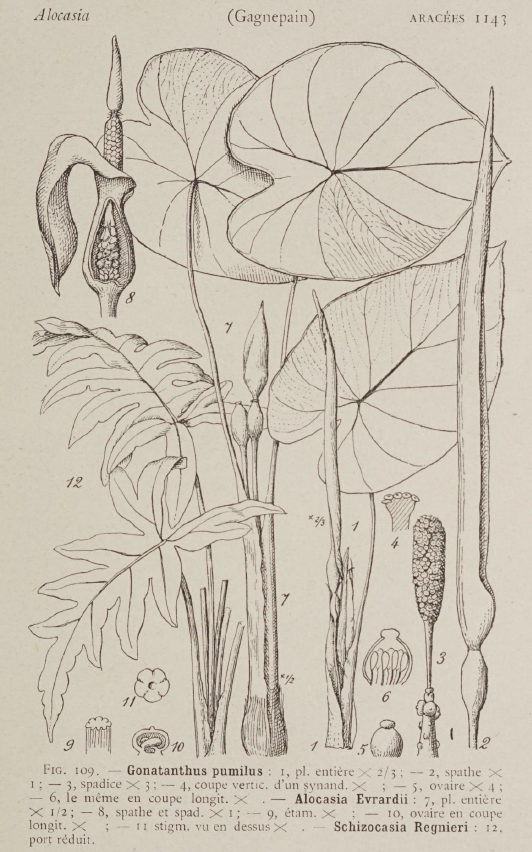ALOCASIA EVRARDII
ORIGINAL DESCRIPTION:
“Plant is 30-60 cm high. Globular rhizome, 2-2.5 cm. in diameter, surrounded by fibers resulting from missing petioles, growing on clumps of ferns or rotting tree trunks.
Leaves are suborbicular, oval, peltate and indented at the base, scarcely acuminate, mucronate at the top, very obtuse, 10-25 cm long and 9-20 cm wide; basilar lobes, 5-8 cm long, fused, 3-5 cm wide, rounded, with acute sinus rounded at the top; 2 basilar veins, corresponding to the lobes, confluent at the base with the lower veins, determining an angle of 35 °, branched; 4-5 primaruy veins on each side, with oblique secondary veins; petiole is 25-30 cm long, broadly sheathing below the middle.
Inflorescence:
Spathe 8-12 cm long ; green tube, 3 cm long, ovoid-fusiform; blade lanceolate, 5-8 long, tapering at base, acuminate at tip, yellow outside, blood-red above, first erect, later refracted; peduncles 1-2, 13-18 cm long
Spadix 6 cm long. ; female part 2 cm long. fertile in the middle on 1 cm., With aborted ovaries above and below; male part 25 mm long, golden yellow, fertile about 22, sterile above and below, the stamens transformed into long, spreading hairs; lanceolate-conical appendage, 2 cm long
Stamens: synanders 2 mm wide. with a polygonal and plurilobulated vertex; boxes 12-14, vertical, contiguous. Globular depressed ovary; stigma discoid, concave in the middle, 1 mm wide, vaguely 4-5-lobulated; 2 basal ovules.
ANNAM (Name for the French Protectorate encompassing current day Central Vietnam): Dalat (Evrard, Hayala); Cua-tung (Cadière); CAMBODIA: Peunonges, Chedom (Thorel). - Living in the Greenhouses of the Museum (1940)- Malay Peninsula.”
Described by François Gagnepain based on collection by the French collector, François Evrard
SYNONYMS: N/A
DISTRIBUTION: Vietnam, Cambodia | Lam Dong and Binh Thuan provinces, S. Vietnam, and Quang Tri province, C Vietnam; also Peunongs, Cambodia. Recent records only from Binh Thuan.
CLIMATE: Ranging from Tropical (rainforest and savannah) in central Vietnam, to temperate (dry winter, hot summer) in NE Vietnam
Humidity is moderately high throughout the year, ranging from 75% to 85%
Temperature across the northern half of Vietnam can vary, generally staying within the range of 50°F/10°C to 86°F/30°C throughout the year
High rainfall during monsoon months (Jun-Sep: can be as high as 2,400 millimeters) and an average of 30 millimetres monthly in the dry season, depending on locality.
ECOLOGY: Alocasia everardii grows in humus deposits on sandstone under semi-evergreen forest at about 400 m above sea level.
SPECIES DESCRIPTION:
Alocasia evrardii differs from all other species of Alocasia except A. vietnamensis in having a stipitate spadix with staminodes at the base of the female portion; it is close to Amorphophallus putii (from Thailand) in its tuberous stem, but differs from that species in having ovate to suborbicular leaf blades (vs. elliptic in A. putii); it differs from A. vietnamensis in having a tuberous stem, peduncles c. ½ as long as the petioles, and a spathe limb dark green when young, light yellow at the base and violet-pink distally at anthesis, becoming reddish violet before falling off.
Herbs seasonally dormant (?), 40–60 cm tall; stem tuberous, subglobose, 2–2.5 cm in diam., outside covered by fibres originating from dried petiole sheaths. Leaves 2 or 3 together, moderately peltate; petiole slender, 40–42 cm long, c. 1.5 cm in diam., sheathing for 10–14 cm from base, sheath light to medium green, sometimes light reddish to brownish, c. 1.5 cm wide at widest point; blade lighter green abaxially, medium green adaxially, ovate to suborbicular, 12–17(–25) × 10–15(–20) cm, base cordate and shallowly concave, apex obtuse or rounded, abruptly and conspicuously cuspidate, cusp 1–1.5 mm long; basal lobes adnate for c. 3 cm, semiorbicular or semielliptic, 5–6 × 5–6 cm; veins: primary lateral veins c. 5 pairs, basal veins c. 2 pairs, minor veins originating from both lateral veins and midrib and proceeding directly or indirectly forward to margin
INFLORESCENCE:
Inflorescences 2–4 together, maturing sequentially; peduncle encased by a cataphyll for c. ⅓ its length, pale to medium green, more slender than petiole, c. 20 cm long; spathe 9.5–12 cm long; tube ovate to elliptic, 2–3 cm long, 1.5 cm in diam., persisting in fruit; limb dark green when young, light yellow at base and violet-pink distally at anthesis, becoming reddish violet before falling off, cymbiform at anthesis, 8–10 cm long, c. 4 cm wide when flattened; spadix stipitate, shorter than spathe, c. 6.5 cm long; stipe rather stout, c. 4 mm long; female portion slightly conical, c. 6 mm long, 2–2.5 mm in diam., base overed by staminodes; sterile portion slender, c. 15 mm long, 1.5–2 mm in diam., covered by staminodes; male portion light brown, oblong, c. 15 mm long, c. 4 mm in diam. at middle; appendix stipitate or sessile, dull white or light brown when young, light yellow or deep yellow during and after anthesis, stoutly subulate or subcylindric, c. 18 mm long, surface with many shallow concavities when young, deeply and elongate sulcate during and after anthesis, base truncate or oblong, equal to male portion in diam., apex acute; appendix stipe brown, 1–4 mm long, covered by thin soft projections. Female flowers: ovaries unilocular, subglobose, c. 1 mm in diam.; ovules 2–4, basal; style conspicuous, c. 0.3 mm long; stigma lobed, concave medially, margin shallowly divided into 4 lobes. Male flowers with 6 or 7 stamens united into a synandrium, 1.5–2 mm wide. Staminodes at base of female portion prominent, creamy brown to dark brown, 1.5–2 × c. 0.6 × c. 1 mm, surface concave at middle; staminodes of sterile portion long, flattened, parallelogram-shaped, 1–1.5 mm long, c. 0.3 mm wide, those at base of sterile portion longer, slightly concave at middle.
Spathe dark green when young, light yellow at the base and violet-pink distally at anthesis, becoming reddish violet before falling off.
VARIEGATED FORMS: N/A
ETYMOLOGY: The specific epithet evrardii was coined by Gagnepain in honour of the French collector, François Evrard (1885–1957), who collected in Vietnam during the years 1923–1929.
NOTES:
Alocasia evrardii was collected from three locations in Cambodia and Vietnam prior to 1942, when Gagnepain originally described the species. Since that date, it appears that no further gatherings were made from the forest around Da Lat (Lam Dong province, Vietnam). Meanwhile, the forests at Cua Tung (Quang Tri province, Vietnam) and Chedom (Peunongs, Cambodia) have been reduced in size or destroyed. However, in 2009, a small population with several tens of plants was found in the Takou Nature Reserve (Binh Thuan province, Vietnam). Further research is needed to gain a more complete and detailed knowledge of the distribution, size and stability of populations of the species. According to IUCN (2012) criteria, A. evrardii is provisionally categorized as Data Deficient (DD)
Additional specimens seen (paratypes) — Vietnam: Lam Dong province: Dalat, 10 Jun 1921, B. Hayata 758 (P 00751089); Binh Thuan province: Takou Nature Reserve area, 2 Oct 2009, H. T. Luu 428, H. T. Luu 429, H. T. Luu 431 & H. T. Luu 432 (VNM), H. T. Luu 430 & H. T. Luu 433 (HN). — Cambodia: Peunongs, C. Thorel (P 00751090); Chedom, C. Thorel (P 00751087).
CULTIVARS: N/A
HYBRIDS: N/A
REFERENCES:


